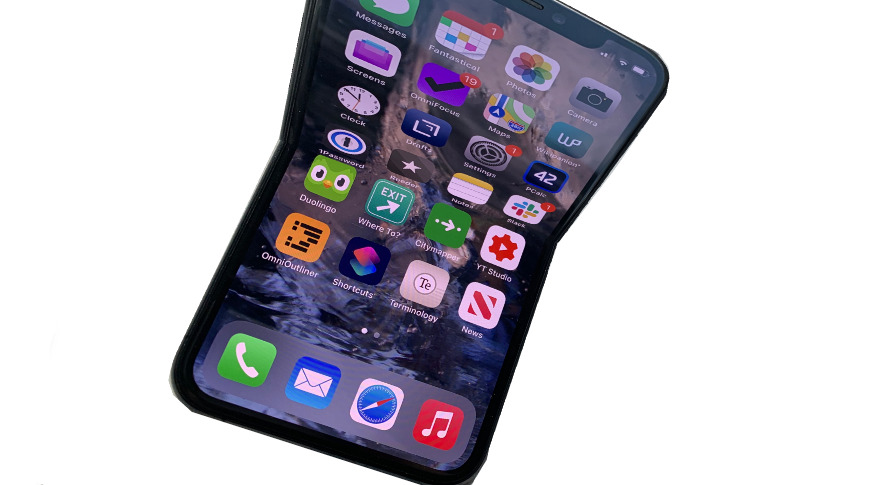Supply chain reports are claiming that the long-term assembly partner Foxconn is now testing a folding iPhone for Apple, and also that devices may ship starting in September 2022.
Potentially backing up a recent claim that Apple has ordered screens for a foldable iPhone from Samsung, a new report says that Foxconn is now testing such a device. Reportedly, the testing centers on the use of OLED or micro LED, as the choice will affect how production of a final device will be done.
According to China's United Daily News, Apple has asked Foxconn to test the screen, and also the bearings of a folding iPhone device. The bearings, the actual folding element, will reportedly come from multiple suppliers, but the final assembly is to be handled by Foxconn.
Previous reports have claimed only that a folding iPhone may be years away. However, based on information from its unnamed supply chain sources, United Daily News claims that Apple is expected to release the first foldable iPhone from September 2022.
The publication says that folding tests for regular laptops requires them to be opened and closed between 20,000 and 30,000 times. For a folding iPhone, it says Foxconn will conduct over 100,000 opening and closing tests.
This new report gives no details of the design of the folding iPhone, and its sources say that development is constantly changing. However, recent claims by leaker Jon Prosser say that the foldable iPhone will be a two-screen device, similar to the Microsoft Surface Duo.
 William Gallagher
William Gallagher




-xl-m.jpg)



 Amber Neely
Amber Neely

 Malcolm Owen
Malcolm Owen

 Mike Wuerthele
Mike Wuerthele


 Thomas Sibilly
Thomas Sibilly







28 Comments
The Microsoft duo is such a pointless device.
id be shocked if Apple did anything resembling the Duo.
I know people like to make fun of folding mobile devices, I think the problem is that it hasn’t been done well yet. I assume a well thought out and a well done folding device that is durable could be awesome.
Somebody outside of Apple, testing a new Apple prototype design, two years before production. That sounds totally legit.
I wrote this here in early 2019. I think it still, mostly, stands...
My John Oliver impression...
Last week Samsung introduced a future-thinking folding phone. Future-thinking in that nobody at present can think of a single reason why we’d want a phone that when folded has a small narrow display and is nearly two and a half times thicker than an iPhone. Future-thinking in that someone, someday, might think of a reason we want a small square tablet with a screen that when touched reminds us of a giant 1980’s membrane switch.
I know, I know, my Apple wool is preventing me from seeing the brilliance of Samsung’s move. All I’m able to perceive here is an attempt to be first. On that score Samsung has won yet another round, another pyrrhic victory for their side of the ledger. And yes, Apple may follow, but not down the same trail Samsung is blazing. For Apple to offer a foldable phone, there still exists some real challenges:
Appropriate hardware technology would have to be available.
First, the display would need to be covered with a non-malleable and scratch-resistant surface; there’s little chance Apple would return to a malleable and markable, plastic display cover. The challenge is that the necessary display properties are, of course, incompatible with folding and are likely to remain so.
Next, the phone when folded will need to be as ready to hand, and pocket, as current iPhones, to which any foldable iPhone, in folded configuration, will be ruthlessly compared. The rumor that Apple may bolster battery capacity in the 2019 models could result in thicker iPhones, which would help in a comparison of a future foldable model. Apple would be settting the stage for a thicker handset with a meaningful enhancement to justify it. But it would still be a significant challenge to then add a second screen layer and not significantly increase the thickness. Perhaps a flattened battery on one side of the fold and all the electronics and cameras on the other fold. Not sure if Samsung did that, or if it’s even viable.
Next there’s the reliability aspect. iPhones, and high-end Android phones, are all very solidly constructed these days, with few or no moving parts. But that doesn’t imply even today’s phones are free of physical wear and tear or immune to extreme conditions. Extreme cold or heat will be significant issues to account for in selecting materials and designing folding phones to yield a similar lifespan compared to their non-folding counterparts. For iPhones that implies a five- or six-year lifespan. Not to mention tensile stresses of the folding process itself.
The only viable solution my limited brain can conceive is two separate displays, each pressed up hard against a lip on a hinge to prevent dust or cookie crumbs intruding. As the phone unfolds, at the last part of the arc, that lip recedes, allowing the two screen edges to come together perfectly, leaving not a single pixel width gap between. How incredibly precise would such a mechanism need to be... boggles the mind. But if it worked, every time, for five or six years, it would allow two glass-covered displays to perfectly come together as one, without a visible seam.